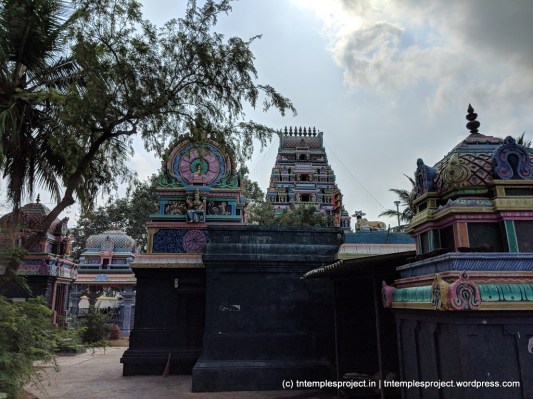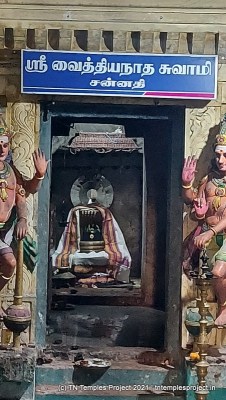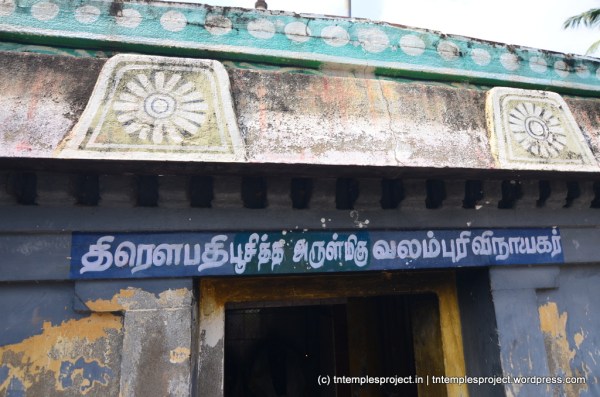
A verse that occurs in the tenth anuvakam of Sri Rudram reads as follows:
या तेरुद्र शिवा तनूः शिवा विश्वाह भेषजी । शिवा रुद्रस्य भेषजी तया नोमृड जीवसे॥
Yaa te rudra shivaa tanu shivaa vishvaaha bheshaji | Shivaa rudrasya bheshaji taya no mruda jeevasae||
This translates to: “Oh Lord Rudra! By that form if your which is peaceful and auspicious, more highly auspicious since it is a panacea for human ills for all days, most highly auspicious since by the grant of knowledge and illumination, it utterly uproots ignorance and the entire misery of samsara, by that gracious form of yours, make us lead a full and happy life.”
The simple meaning of this is a reference to Siva as Rudra, peaceful and auspicious, and the panacea for human ills. Vaidyanathar or Vaitheeswaran literally means the curer of ills, and this temple is indeed worshipped by people who want to rid themselves of illnesses. The deeper, spiritual meaning is that the illness referred to is life on earth itself, and the cure is mukti.
Notwithstanding the thousands of Siva temples in Tamil Nadu and the hundreds where He is worshipped as Vaidyanathar or Vaitheeswaran – the curative force against all illnesses, three stand out as prominent temples in the state: Vaitheeswaran Koil (the famous one between Sirkazhi and Mayiladuthurai), the Uttara Vaidyalingeswarar temple at Kattur (close to Mamallapuram on the outskirts of Chennai) and the Vaidyanathar temple at Madavar Vilagam (near Srivilliputhur).
But few are perhaps aware of five Siva temples near Vaitheeswaran Koil, all of which are regarded as being older than the Vaidyanathar temple at Vaitheeswaran Koil. The moolavar in all these temples is called Aadi Vaidyanathar, referring to the earliest representation of Siva as Vaidyanathar, further reinforcing the primacy of these temples before Vaitheeswaran Koil. Equally interesting is the Mahabharatam connection between these temples, as well as some other temples in the region.

The very first of these (not by chronology – that is not recorded) is the Aadi Vaidyanathar temple at Mannipallam. It is said that some of the vigrahams from this temple were taken and re-consecrated at Vaitheeswaran Koil when the latter was first built. The second temple in this series is the Aadi Vaidyanathar temple at Radhanallur. This west-facing temple is regarded as very powerful, and is famous for Surya puja. Both temples are located on the road from Vaitheeswaran Koil to Pandanallur.
The third is the Vaidyanathar temple at Varagadai (or Varakadai, and not Vadakarai – a simple mistake that can lead to missing the place by several kilometers. In fact, over time, the Vadakarai near Sembanar Koil has come to be believed as the Vaidyanathar temple in question, which is utterly incorrect.) This place is located 5-6 km south of Manalmedu. Today, the moolavar of the temple goes by the name of Varundeeswarar.
The fourth is the Vaidyanathar temple at Aivanallur, which is believed to have been a vast temple in its time – perhaps 1000-2000 years ago, but is reduced to a tin shed today. The fifth is the Aadi Vaidyanathar temple at Pandur. Both these temples are located close to Korukkai, site of the Ashta Veerattanam temple for Siva as Veeratteswarar.
All five temples are considered Sevvai Dosham parikara sthalams. It is customary to complete a visit to the Pancha Vaidyanathar sthalams, by worshipping at Vaitheeswaran Koil.
Now we come to the Mahabharatam connection.
Local retelling of the epics – particularly Ramayanam and Mahabharatam – have significant emphasis on the exile period of the primary characters, and link them to places in the region. This is no different in the case of this region of Tamil Nadu, and the Mahabharatam (as also, separately, the Ramayanam).
In the Mahabharatam, when the Pandavas were in exile, all five of them fell ill. They approached Krishna, who advised them to consecrate and worship a Lingam for Lord Siva as Vaidyanathar, in order to be cured.
At the same time, in Kailasam, Lord Siva heard Krishna’s words, and make the vilvam tree in Kailasam shake. This led to five vilvam leaves separating from the tree, and falling in Bhulokam at specific spots in and around where the Pandavas were staying.
When the Pandavas decided to search for a spot each to install a Lingam, they each found one of the five places where the celestial vilvam leaves had fallen. At these spots, the five Pandavas consecrated a Lingam and prayed to it, and in this way, they were all cured. These five places are what are today the five Pancha Vaidyanathar sthalams.
Interestingly, the name Pandur is a reference to the Pandavas, and supposedly the place where they lived here for a while during their exile. Aivanallur, which is also close by, has the same etymology, and derives from Aivar-Nallur (aivar being a Tamil reference to the five Pandavas).
The Pandavas, along with their mother Kunti and wife Draupadi, worshipped Lord Siva at a few other temples in the vicinity as well. These include:

- The Abatsahayeswarar temple at Ponnur where Siva is also called Pandaveswarar.
- Neelakanteswarar temple at Iluppaipattu, where there are 5 Lingams (including the moolavar), which are named for each of the five Pandavas.
- The Sivaloka Nathar temple at Tirupungur (also known as the Nandanar temple) has five Lingams in the prakaram. While one account states that these represent the five faces of Siva, the other is that these were installed by the five Pandavas.
Because of Krishna’s timely help in advising them, the Pandavas also erected a temple to honour Him, at Pandur where they lived. This is today the Pandava Sahaya Perumal temple, for the Perumal who came to the assistance of the Pandavas.
Next time you visit this region, please do make time for the Pancha Vaidyanathar temples. Including the drive, the five temples should not take more than 4-5 hours to visit. One can stay in Kumbakonam, Mayiladuthurai or Vaitheeswaran Koil, and visit these temples, and round it off by going to Vaitheeswaran Koil and worship Siva as Vaidyanathar there.
